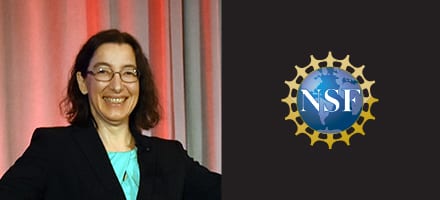By Maya Gurarie, Digital Experience Specialist
Estimated reading time: 4 minutes
 Dana Brunson
Dana Brunson
As the Principal Investigator for a new $1.49M National Science Foundation grant, Dana Brunson has big plans. The grant fuels the development of a national career center by providing products, tools, services, and communities to sustain Research Computing and Data (RCD) operations and builds on years of collaboration between research computing professionals that has previously been mainly unfunded.
“It blows my mind that we have accomplished as much as we have and we’re going to keep going. If you had asked me 3 years ago if we had come as far as we have, I would have been extremely skeptical,” said Internet2 Executive Director for Research Engagement Dana Brunson.
Creating a Job that Didn’t Exist Before
To understand how Brunson will focus the grant research, it’s worth noting what led her to this point. After earning her bachelor’s and master’s degrees in mathematics at Oklahoma State University (OSU), Brunson did graduate work in applied math at the University of Texas at Austin. As a working mom, she searched for a position so she could work part-time. She moved back to Stillwater, Oklahoma to serve as an adjunct math professor at OSU, then applied for and got the job to manage OSU’s High Performance Computing Center. She started out as a one-person shop, so she reached out for support to Campus Champions (XSEDE), OneOklahoma Cyberinfrastructure Initiative (OneOCII), and the Great Plains Network (GPN).
Professionally and personally, Brunson has benefited from these regional networks and the relationships she gained through her involvement. As she attracted grants and grew OSU’s High Performance Computing Center, Brunson gave back to these communities. She took on a leadership position at Campus Champions and became a staff member after they received a second 5-year grant XSEDE 2 in 2016. A mentor encouraged her to join the Campus Research Computing Consortium (CaRCC). Soon Brunson was working on NSF workshops to collaborate with CI professionals on building a national and global workforce.
In 2019, Internet2’s Vice President of Community Engagement Ana Hunsinger recruited Brunson to lead the new Research Engagement team. Brunson directs Internet2’s strategy and active engagement with communities that support the effective use of research CI.
Looking back on her career, Brunson said, “Most of my life, the job I have now didn’t exist before I had it.”
Leading the Community of Communities
Brunson leads a team of Co-Principal Investigators for the NSF grant including Thomas Cheatham, Scott Yockel, Patrick Schmitz, and Claire Mizumoto. They are tackling two challenges at once. Firstly, the Research Computing and Data Capabilities Model will help institutions benchmark their ability to enable computational research. Secondly, the team is building a pipeline for workforce development. They are developing resources including a HR Job Family Matrix and a RCD professional survey, which is ongoing and open to RCD professionals.
One of the more ambitious aspects of the grant is cultivating a community of communities. In short, the pilot project will help the RCD community achieve goals they couldn’t do on their own. Organizations such as the Coalition for Academic Scientific Computation (CASC), Campus Champions, CaRCC, US Research Software Engineers (US-RSE), and the Research Computing and Data Community Group (EDUCAUSE) contribute to RCD needs. However, their services overlap, and sometimes they don’t combine resources.
“We need to all come together and have mechanisms to understand what the community as a whole sees as the future, where we need to be working and investing in to serve the kinds of research that’s going to happen in 10 years,” said Brunson.
Gathering Virtually and in Real Life
Next steps for the team leading the NSF grant include finalizing a national survey of computational research professionals. While remote meetings have proved convenient and effective during the pandemic, Brunson is looking forward to the informal conversations that happen when she meets with her colleagues in person. As the rollout of pandemic vaccinations continues globally, it will take time to for in-person gatherings to be budgeted for and planned. The Practice and Experience in Advanced Research (PEARC) conference will remain virtual in July. An important industry conference will be held in person this November— SC21 (The International Conference for High Performance Computing, Networking, Storage, and Analysis) in St. Louis, MO. With most of the NSF grant research yet to be done, Brunson says it’s hard to choose what she’s looking forward to the most.
“I’m most excited about how we’ve gotten to a point where people are really recognizing this as an emerging profession. It took years and still not everyone knows that there are these people who help researchers use technology. They are enabling researchers to use the technology to do things we couldn’t otherwise do. They work in the art of the possible,” said Brunson.
Read more about the Resource and Career center Pilot for Advancing Computational and Data-intensive Research in this press release.